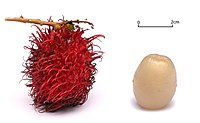
High abundance of pyrrolizidine alkaloids in bee pollen collected in July 2019 from Southern Germany
Sign Up to like & getrecommendations! Published in 2022 at "Environmental Monitoring and Assessment"
DOI: 10.1007/s10661-022-09907-8
Abstract: Pyrrolizidine alkaloids (PA) are secondary plant defense compounds and known pre-toxins when containing a 1,2-double bond. They are commonly produced by various plants and may thus be present in bee pollen which may be consumed… read more here.
Keywords: southern germany; pyrrolizidine alkaloids; pollen; july 2019 ... See more keywords

Changes of microorganism composition in fresh and stored bee pollen from Southern Germany
Sign Up to like & getrecommendations! Published in 2021 at "Environmental Science and Pollution Research"
DOI: 10.1007/s11356-021-13932-4
Abstract: Analysis of plant pollen can provide valuable insights into the existing spectrum of microorganisms in the environment. When harvesting bee-collected pollen as a dietary supplement for human consumption, timely preservation of the freshly collected pollen… read more here.
Keywords: storage; bee pollen; collected pollen; composition ... See more keywords

Bee bread and bee pollen of different plant sources: determination of phenolic content, antioxidant activity, fatty acid and element profiles
Sign Up to like & getrecommendations! Published in 2020 at "Journal of Food Measurement and Characterization"
DOI: 10.1007/s11694-020-00427-y
Abstract: This study aims to determine the plant sources, fatty acid composition, total phenolic-flavonoid content, antioxidant capacity, and elemental profile of bee pollen (BP) and bee bread (BB) samples from the same bee hive in different… read more here.
Keywords: content antioxidant; bee pollen; fatty acid; content ... See more keywords

The impact of solid-state fermentation on bee pollen phenolic compounds and radical scavenging capacity
Sign Up to like & getrecommendations! Published in 2018 at "Chemical Papers"
DOI: 10.1007/s11696-018-0417-7
Abstract: The aim of this study was to perform solid-state fermentation of bee collected pollen by lactic acid bacteria and evaluate the impact of fermentation to total phenolic compounds content, total flavonoid content and radical scavenging… read more here.
Keywords: solid state; bee pollen; state fermentation; fermentation ... See more keywords

Effect of bee pollen extract as a source of natural carotenoids on the growth performance and pigmentation of rainbow trout (Oncorhynchus mykiss)
Sign Up to like & getrecommendations! Published in 2020 at "Aquaculture"
DOI: 10.1016/j.aquaculture.2019.734490
Abstract: Abstract In this study, carotenoids were extracted from bee pollen using sunflower oil as a solvent, and the extract was incorporated into pellets for trout feeding. A total of 144 rainbow trout were fed over… read more here.
Keywords: pollen extract; rainbow trout; growth; bee pollen ... See more keywords

Identification of cattail pollen, pine pollen and bee pollen by Fourier transform infrared spectroscopy and two-dimensional correlation infrared spectroscopy
Sign Up to like & getrecommendations! Published in 2018 at "Journal of Molecular Structure"
DOI: 10.1016/j.molstruc.2018.04.076
Abstract: Abstract Cattail pollen (CP) and pine pollen (PP) are traditional Chinese medicine, which are used for bleeding blood and immunity enhancement activity respectively. Due to the economic benefits, they are occasionally adulterated with bee pollen.… read more here.
Keywords: infrared spectroscopy; bee pollen; cattail pollen; pollen pine ... See more keywords

Determination of metals as bio indicators in some selected bee pollen samples from Jordan
Sign Up to like & getrecommendations! Published in 2019 at "Saudi Journal of Biological Sciences"
DOI: 10.1016/j.sjbs.2019.03.005
Abstract: This study was done to determine the degree of metals and heavy metals in some bee pollen sample as biological indicator for environmental pollution. Sample were collected from industrial, urban and agricultural areas of Jordan… read more here.
Keywords: bio indicators; bee pollen; metals bio; indicators selected ... See more keywords

Determination of Pesticides in Bee Pollen: Validation of a Multiresidue High-Performance Liquid Chromatography-Mass Spectrometry/Mass Spectrometry Method and Testing Pollen Samples of Selected Botanical Origin.
Sign Up to like & getrecommendations! Published in 2022 at "Journal of agricultural and food chemistry"
DOI: 10.1021/acs.jafc.1c06864
Abstract: Pollen is a source of nutrients for honeybees (Apis mellifera L.) and suitable for human consumption as well. In our research, a multiresidue method for pesticide determination was developed and validated for the bee pollen… read more here.
Keywords: bee pollen; mass spectrometry; validation; method ... See more keywords

Bee Pollen Extracts Modulate Serum Metabolism in Lipopolysaccharide-Induced Acute Lung Injury Mice with Anti-Inflammatory Effects.
Sign Up to like & getrecommendations! Published in 2019 at "Journal of agricultural and food chemistry"
DOI: 10.1021/acs.jafc.9b03082
Abstract: Bee pollen (BP) collected from different floras possesses various potential bioactivities, but the mechanism-related research on anti-inflammatory effects is limited. Here, three types of BP originating from Camellia sinensis L. (BP-Cs), Nelumbo nucifera Gaertn. (BP-Nn),… read more here.
Keywords: anti inflammatory; bee pollen; lung injury; inflammatory effects ... See more keywords

Lipidomics Provides Novel Insights into Understanding the Bee Pollen Lipids Transepithelial Transport and Metabolism in Human Intestinal Cells.
Sign Up to like & getrecommendations! Published in 2019 at "Journal of agricultural and food chemistry"
DOI: 10.1021/acs.jafc.9b06531
Abstract: Bee pollen (BP) shows profound gut-protecting potentials. BP lipids (BPL) mainly composed by phospholipids and polyunsaturated fatty acids might be one of the important contributors, while how BPL exerts gut-protecting effects and transports through intestinal… read more here.
Keywords: human intestinal; cell; transport; bee pollen ... See more keywords

Potential therapeutic effect of thymoquinone and/or bee pollen on fluvastatin-induced hepatitis in rats.
Sign Up to like & getrecommendations! Published in 2021 at "Scientific reports"
DOI: 10.1038/s41598-021-95342-7
Abstract: Hepatitis is one of earlier, but serious, signs of liver damage. High doses of statins for a long time can induce hepatitis. This study aimed to evaluate and compare the therapeutic potential of thymoquinone (TQ)… read more here.
Keywords: fluvastatin induced; bee pollen; hepatitis; pollen fluvastatin ... See more keywords